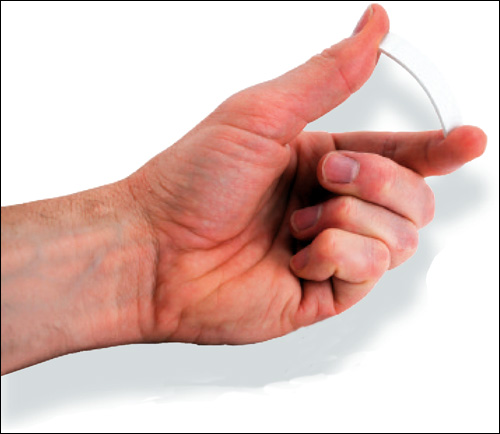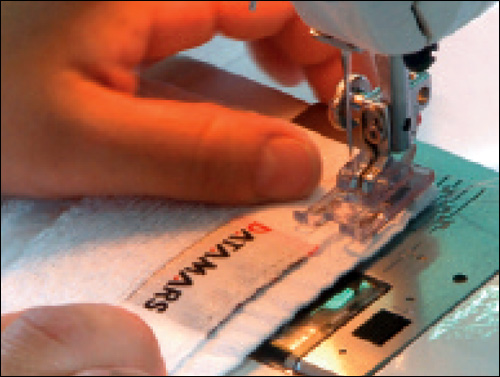Apr 15, 2013Commercial laundry companies have been RFID-tagging and tracking uniforms and linens for more than 15 years to identify customers' items, which must be sorted, cleaned, packaged and loaded on the correct truck for delivery. More recently, casinos, fitness clubs, hospitals, hotels, theme parks and other organizations have begun using RFID to track laundry items, to improve asset visibility and reduce the number of stolen towels.
"Laundry tracking manually is very labor-intensive, because keeping detailed records requires that different types of laundry items must be separated, counted, recorded on paper and then later entered into a computer," says Jeff Welles, VP of RFID laundry solution provider InvoTech Systems. "RFID automatically identifies, counts and records the items without even separating or sorting."
While laundry-tracking systems have been in use for a long time, recent advancements in the technology have led to price drops and increased performance, says Michael Liard, RFID director at VDC Research. Low-frequency and high-frequency solutions dominated the market in the early days, he says. Passive ultrahigh-frequency solutions able to withstand washing conditions have entered the market as lower-cost alternatives. In general, he adds, these systems cost approximately 20 percent less than the older offerings.
UHF RFID tags designed to withstand commercial laundry processes first became available in 2010, Welles says. "These tags each contain a unique ID number and are attached to each uniform or linen item to identify specific inventory items," he explains. "The UHF RFID laundry tags allow inventory items to be processed from a much farther distance than the RFID laundry tags that were previously available." The greater reading distance allows for entire laundry carts of uniforms or linens to be processed and the content recorded instantly, he adds.
Some companies hire a systems integrator to develop a laundry-tracking system; the integrator then purchases laundry tags from an RFID provider. Other firms design their own RFID laundry solutions. Disney, for instance, purchased passive UHF tags from Fujitsu Frontech North America and readers from ThingMagic, and created RFID software that integrates with its existing Garment Utilization System.
During the past few years, providers have developed complete laundry solutions, which include readers, tags and software—an option that makes sense, Liard says. In 2011, for example, Fallsview Casino Resort, in Niagara Falls, Canada, adopted InvoTech's GIMS Uniform System. Still, employees needed to sew the tags into tens of thousands of employee uniforms.
Analysts and solution providers expect continued growth in the RFID laundry market. "There is an explosion in usages for washable RFID tags," says Dan Dalton, director of new products development at Fujitsu Frontech North America. "From hospitals and health care to hotels and entertainment venues, the demand for tracking clothing and linens is increasing in many markets for a variety of reasons." Hospitals need to track linens and materials not only entering and exiting facilities, but in many cases from floor to floor and room to room, Dalton says. Hotels need to ensure linens are available for guests. And with the rising cost of cotton, loss of items can have a significant impact on a hotel's bottom line.
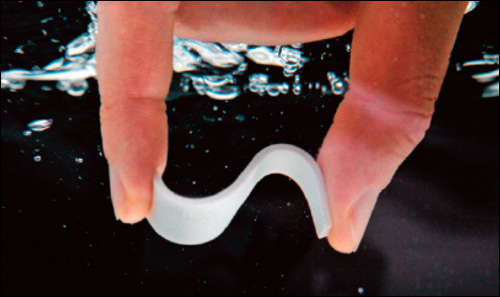
"Laundry tags can also be used to track cleaning equipment, such as textile mops and broom heads, which are laundered and sterilized," says Richard Aufreiter, director of product management, identification technologies, at HID Global. "Textiles of all types, including napkins and tablecloths, are tracked for accountability, efficiency and traceability purposes."
While the RFID laundry sector is growing, Liard says, companies in the industry face the ongoing challenge of communicating the business benefits of RFID for laundry-related applications. "Education is still a challenge, and with the new UHF solutions as part of the equation, customers now have more of a choice," he says. "They need to understand things like total cost ownership and ROI."
RFID Laundry Tags
Companies that want to build their own laundry-tracking systems or invest in additional tags to expand monitoring capabilities have several options; the table on page 35 provides information on some leading RFID laundry tag providers. All the RFID laundry tags are rugged—that is, they can withstand hundreds of industrial washings at high temperatures with bleach and other chemicals, as well as repeated ironings. Solution providers say the laundry tags usually outlive the uniforms and other linens they track.
Industrial laundry typically is not dried primarily with air but with a water-extraction press. "Although using an extraction press expedites the drying process, it places additional stress on the laundry and the tag's antenna," HID Global's Aufreiter says. "Therefore, HID tags are tested up to 70 bar pressure (½-ton per square inch) and 500 twist tests of 180 degrees for the flexible antenna to survive repeatedly in modern water-extraction presses."
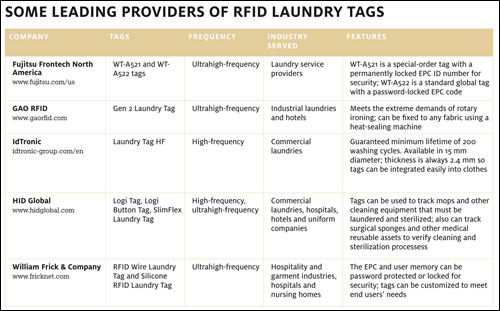
Click here to view a larger version of the above chart.
The tags differ when it comes to size, form factor and read range. Fujitsu's WT-A521 and WT-A522 tags, for example, measure 55 millimeters by 10 millimeters (2 inches by 0.4 inch), so they can be inserted easily into the seam of a sheet or towel, Dalton says. "Because of the ultrasoft exterior, the tag can be inserted into clothing seams, linings or pockets and is virtually unnoticeable to the wearer," he says. Also, because of its nonmetallic design, the tag can be used in hospitals with MRI rooms where large magnetic fields are present, he adds.
Some tags offer security features, such as the ability to protect customer data on tags. "We can lock down as much or as little data as the client needs," says Brent Howell, business development manager at William Frick & Co., which provides the RFID Wire Laundry Tag and Silicone RFID Laundry Tag.
The EPC and user memory can be locked or password-protected to prevent someone from changing data on tags, Howell says.
"Additionally, each chip comes with its own unique serial number that cannot be changed," he says. "If a user combines chip ID along with [the user's] own unique EPC code, this allows for additional security."
RFID Laundry Solutions
InvoTech Systems, RFID Laundry Consultant and Towel Tracker are among the RFID providers that offer complete laundry solutions, including tags, readers and software. With a turnkey system, the hardware and software components work together, and the solution typically includes installation and training, and, in some cases, software updates and support services.
InvoTech offers GIMS systems to manage linens, uniforms, laundry (linens and uniforms) and multiproperty (for clients with more than one site). The company says it has nearly 500 customers in 20 countries worldwide, including casinos, hospitals, hotels, laundries, medical centers, stadiums and theme parks. All the UHF systems automatically track and record laundry activity, and manage inventory, repairs and billing. A "restricted item control" feature can be deployed at employee exits to catch individuals trying to leave the property with uniforms, Welles says, or it can be used at pools or water parks to prevent guests from stealing towels.
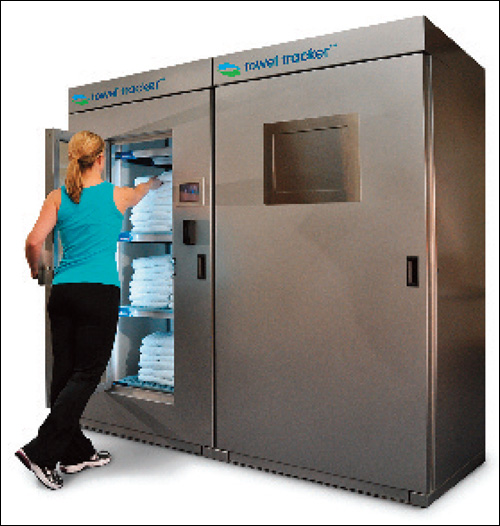
The implementation time for a laundry system can take as little as one day or as long as a month, he says, depending on what the customer is looking to do. "Cost varies tremendously depending on the size of the operation," Welles says. InvoTech provides custom pricing proposals and a return-on-investment analysis, he adds.
RFID Laundry Consultant's Simple Sort was developed with help from RFID company Datamars. The HF system is designed for industrial laundry and cleaning companies, specialized laundry facilities, such as those that handle clean-room uniforms, and hotels, says Scott Meyer, the firm's owner and product engineer. The system features a "cube" that automatically sorts floor mats and uniforms, reducing errors and labor. It also alerts the operator to any special requests, such as repairs needed or the fact that a replacement item has been sent to the customer.
The cost of Simple Sort starts at $25,000, including software, one reader station, installation, training and some tags, Meyer says. Customers pay more for additional tags, on-site training and programming modifications. "Each system is customized for each customer," he says.
Towel Tracker's solution is designed for fitness clubs and hotels, which lose millions of dollars in stolen towels every year, according to CEO Steven Molewyk. An introductory version includes a towel-dispensing unit, a towel-return unit, RFID-tagged towels, two rolling carts for dispensing clean towels, and two rolling laundry bins for dirty towels. Towel Tracker costs approximately $30,000. "Our clients have seen ROIs between 10 weeks and five months," Molewyk says. "This is due to lower towel theft, reduced laundry expenses, and the ability to charge patrons the purchase price for stolen towels."
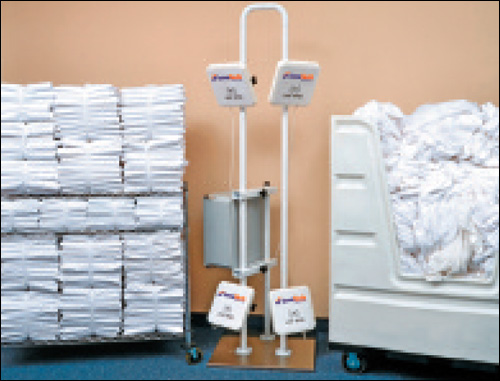
When a guest swipes his or her fitness-club membership card or hotel key card through a card reader, a cabinet door opens automatically, allowing the user to remove as many towels as needed. Then, the system performs a tag scan and determines the exact number of towels taken. "Towel Tracker's computer system automatically assigns those towels to your account," Molewyk says, "It's like checking out books from a library."
Used towels are placed in the Towel Tracker's return unit, which scans the RFID tags and automatically removes those towels from the guest's account. Managers can pull up a real-time list showing guests' names, the number of unreturned towels, and the date and time the towels were checked out. The system can be set to automatically generate polite e-mail reminders asking patrons to return the missing towels or face potential replacement fees.
People use significantly fewer towels when they're responsible for returning them, Molewyk says, which means fewer towels to wash. Laundering costs about eight cents per towel, he says, and the savings can add up quickly.
Cleaning Up
Many companies see the initial inventory tagging as a challenge. If a company is ordering new uniforms and linens, InvoTech sends the laundry tags to suppliers to be sewn in during the manufacturing process. For existing uniforms and linens, the company provides the laundry tags pre-inserted in fabric pouches, which can be sewn into the uniforms and linens, he says. Another option is tags that can be heat-sealed to uniforms and linens; the company offers a heat-seal machine.
Simple Sort's Meyer says he has shipped machines to customers to help in the tagging process. "Most every company ends up buying its own, because of the need to tag existing stockroom inventory," he says. "A typical company will have a stockroom that is 15 percent of the active inventory. So if it converts 100,000 active garments, it will need between 10,000 to 20,000 tags for the stockroom. It is more cost-effective to add the tags only when they are put into service... This same machine can be used for sewing on name and company emblems."
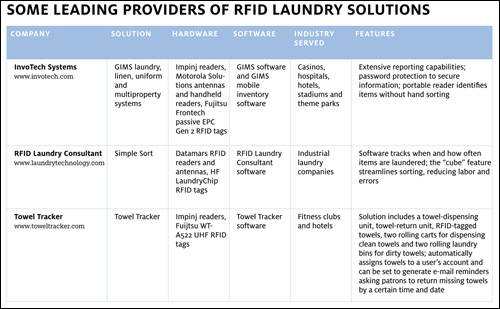
Click here to view a larger version of the above chart.
Domestic linen mills "have a huge opportunity to provide value by tagging towels at the mill and shipping them directly to customers' sites," Towel Tracker's Molewyk says. "I believe only domestic mills can excel at this lean supply model. Unfortunately, nobody, to my knowledge, has adopted this model yet."
The laundry tracking market "is focusing much of its attention on UHF RFID technology and the adoption rate is extremely fast," Welles says. "However, UHF RFID laundry tags have only been available a few years, so only a very small percentage of qualified businesses have implemented systems to date."
Adoption rates will continue to vary depending on the application, Dalton says. "Several years ago, washable UHF RFID adoption was limited to higher-priced uniforms and costumes," he says. "Recently, however, Fujitsu has seen an increase in adoption rates in the hospitality and health-care segments. We expect this rapid adoption rate to continue into the future, as the cost of linens and clothing continues to rise and the cost of tags continues to fall."

